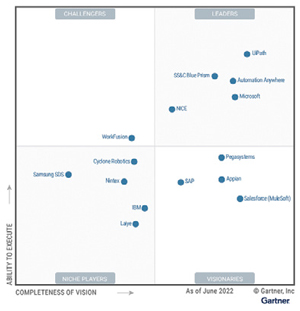THANK YOU FOR SUBSCRIBING

A Record of RPA
Osmond Li, Senior Manager, Head of Technology Innovation, Dah Chong Hong Holdings Limited


Osmond Li, Senior Manager, Head of Technology Innovation, Dah Chong Hong Holdings Limited
Osmond Li, Senior IT Manager of Technology Innovation at Dah Chong Hong (DCH) Holdings Ltd., has many years of enterprise IT project experience including RPA, Workflow, ERP, etc. DCH began looking into new technologies such as AI, machine learning, and RPA a few years for a company-wide transformation to modernize existing processes and reduce operational costs.
After conducting some introductory workshops with examples to employees, such as buying tickets online, the first automation was put into production in just one month. The company implemented simple automation on its own but relied on consultants for help with more complex ones. Following a cost-benefit analysis (CBA), management could easily visualize the ROI RPA would provide. By the second month, five bots were in production.

What is RPA?
RPA, Robotic Process Automation, is the software to automate repetitive tasks within business and IT processes via software scripts that emulate human interaction with the application user interface. In simple terms, RPA is a software robot to mimic human actions in a computer, just like a macro in Excel. Of course, RPA is more than just macro. It can provide screen scraping and scripting programming. Four key RPA players are Uipath, Automation Anywhere, Blue Prism, and Power Automate. (Garter 2022)
Beauty of RPA
The key advantage of RPA is to offload employees from high-volume repetitive labor-intensive tasks. Employees may need to work overtime in weekdays or even in weekends in order to handle these high-volume tasks. By automating these tasks using RPA, employees can be offloaded from boring repetitive tasks and transformed into challenging high-value tasks.
This can increase the employee retention rate. Besides, since RPA can work 24x7 continuously including weekends, this can increase company productivity & can provide a better service level to customers. Another key advantage of RPA is its non-intrusive nature. It means RPA needs not to modify the coding in existing applications. It is common that most enterprises have outdated applications that they may not have the necessary IT expertise to make changes. By using RPA, the company can still build an automated workflow in this kind of application. In this way, this would not create any potential risks or bugs in the applications and can shorten the testing cycle. That is one of the reasons for fast-growing RPA adoption. Last but not least, it is a low-code tool. That means business users can also learn to build or make changes themselves. One keynote to get management buy-in is that manhour cost should be higher than the RPA cost. It is a good practice to build an RPA dashboard to illustrate the ongoing cost saving to management by capturing the actual running frequency.
Why did RPA Fail?
Since the start of the pandemic in late 2019, automation became the key to all CIOs. However, RPA is unable to handle complicated scenarios & it will return errors for exceptional cases. These exceptional cases still rely on a human to handle them. In general, 5-10% of cases will fall into exceptions. On the other hand, users are expecting full automation, not 90-95% automation. Another issue is uncertainty at scale. RPA can only do one task at a time, not multitasking. If there are many requests at the same time, the demand for more RPA capacity will jump up, which will have high-cost implications. Not like traditional cloud computing, RPA cannot be auto-scaled up or down easily. Another obstacle to RPA is due to employees’ layoff fear. It is common that management will cut costs after automation is completed. Because of this, those employees might create obstacles to hinder or prolong the RPA project. In my experience, it is a good practice to provide transformation training to the employees at the beginning of the RPA project to change their mindset and to provide a new career path to transform them to take up high-value tasks (e.g.to convert prospects to customers & increase sales revenue).
RPA Will Continue to Play a Key Role in Enterprise Automation. We Look to Cognitive RPA so that the Bot can Simply Learn by Observing an Activity
Future of RPA
Due to the limitation of rule-based RPA, Cognitive RPA (RPA with AI & NLP capability) has evolved so that RPA can learn simply by observing an activity or task and emulating it without detailed instruction. Like adding optical character recognition (OCR) to RPA to recognize textual content from hardcopy, there may be changes in layout format occasionally. With AI capability, RPA can self-learn to understand the new layout format. The Center of Excellence (CoE) of RPA is also rising. The RPA project is not a purely technical project. It is about people, processes, and technology. It involves the transformation of employees. RPA should be part of enterprise automation. The RPA CoE team should collaborate with the enterprise automation team to identify the best-fit RPA projects. Furthermore, more citizen developers will join the RPA community due to the expansion of low-code and no-code platforms. RPA will continue to play a key role in enterprise automation. Due to the blooming of cloud, RPA pricing should be evolved to become RPAaaS (RPA as a Service) like SaaS, so that a more flexible pricing model can be provided to enterprises to cater to the varying demand of loading in-peak or low seasons across the year.
Weekly Brief
I agree We use cookies on this website to enhance your user experience. By clicking any link on this page you are giving your consent for us to set cookies. More info
Read Also













